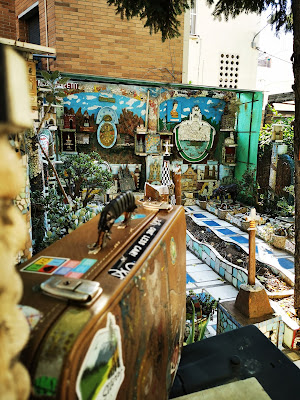 |
pictures courtesy of Anna Fuster (Flickr, 2007) |
The Carrer de Grau in the Sant Andreu quarter of Barcelona still has the atmosphere of past times, with its small houses and front gardens facing a street that has no car traffic.
The residents organize these gardens in various ways and one of them did this in a very special, creative manner.
Life and works
Isidre Castells (1920-2005) at age seventeen was enlisted in the army to take part in the Spanish civil war. Struck by typhus, been imprisoned in a concentration camp and having lost his father and mother, his youth was troublesome and he had to find a way to face life after the war.
He got a job in a factory, worked in the weekends as a home painter, and settled in the Sant Andreu quarter of Barcelona. When in the 1980s the factory went bankrupt, Castells got an early retirement.
Not liking idly hanging around, he began working in the front garden, installing some concrete elements to curb the growth of weeds. This was the start, around 1985, of a project that he would continue for some twenty years.
With the format of big tiles in mind, Castells made two-dimensional replicas of well known architecture in Catalonia, like the Sagrada Familia and Montserrat.
All together, in the course of the years he has constructed some hundred representations of Catalonian monuments, churches, famous buildings, and so on.
With the format of big tiles in mind, Castells made two-dimensional replicas of well known architecture in Catalonia, like the Sagrada Familia and Montserrat.
All together, in the course of the years he has constructed some hundred representations of Catalonian monuments, churches, famous buildings, and so on.
Apart from the replicas on the wall, which give the site a museum-like character, the garden itself has been embellished with mosaic- and shell-decorated structures, like flowerpots, pillars and arcs.
People in Barcelona would be reminded of Gaudi.
People in Barcelona would be reminded of Gaudi.
Castells has been making sculptures too, one of these is a black, mosaic-decorated representation of his beloved dog, as in next picture.
After Isidre Castells died in 2005, his widow Rosa Anglada, would maintain the garden and when she became to old (in 2018 she was at age 92) Josep Castells took care of the site, as reported in the journal El Periódico (see documentation)
Situation in 2021
The picture above, made in October 2021 by Tiramisu Bootfighter, who traveled through Spain in the context of his project La Valise, Galerie Ambulante, shows that the site at that time was still in good condition
Documentation
* a website promoting the quarter of Sant Andreu has pictures of the garden and a text about Castells
* a series of photos (December 2013) by Raija Kallioinen on Facebook
* entry (November 2014) on Amaijak's weblog Mi Mundo, with a series of pictures
* article (January 2018) in local journal El Periódico
* a series of photos (December 2013) by Raija Kallioinen on Facebook
* entry (November 2014) on Amaijak's weblog Mi Mundo, with a series of pictures
* article (January 2018) in local journal El Periódico
Video
* scenes of the site (2012) on the Barcelona trip video by Serflac (YouTube, starts at 19.46, cannot be embedded here)
* scenes of the site (2012) on the Barcelona trip video by Serflac (YouTube, starts at 19.46, cannot be embedded here)
first published June 2012, last revised October 2021
Isidre Castells
Isidre Castells
Catalunya en petit
56/58 Carrer de Grau
Sant Andreu,
Barcelona, Catalunya, Spain
Barcelona, Catalunya, Spain
can be seen from the street
streetview
streetview




What a wonderful blog! I just happened to stumble upon it while searching information on Petit Pierre Avezard and the Musee Fabuloserie (Fafuloserie). I live in a tiny town near New Orleans called Abita Springs. The Abita Springs Mystery House Museum would surely please you. If you ever find yourself in this neck of the woods, I'd be happy to share it with you. I'm looking forward to your future posts. Hopefully one day I can visit some of these magical places in Europe.
ReplyDelete@nolabrooke. Thanks a lot for your comment. I am glad you like my blog. Being myself a lover of creations with movable parts, like gardens with lots of whirlygigs, the construct by Petit Pierre is one of my favourites. It is a moving scene in a variety of meanings.
ReplyDeleteA visit to the Mystery House Museum must be a wonderful adventure. Thanks for sharing this.
Hello! I am an art teacher from the US who is living in Metz, France for the summer. I love taking road trips to visit self-taught artists and offbeat attractions around America- Imagine how excited I was to find your lovely website and find some visual inspiration over in Europe, too! I visited this site (Catalunya en Petit) when I was in Barcelona just over a week ago- http://www.thedailytelecraft.com/2012/07/field-trip-catalunya-en-petit.html
ReplyDeleteI am very excited about visiting Maison Picassiette next week along with some other sites in Paris that I found because of your blog! Terrific stuff! Please let me know if I can help you at all! :)
-Katie
@ KTBurn. Hi Katie, Thanks a lot for your comment. I wrote you a PM via email.
ReplyDelete